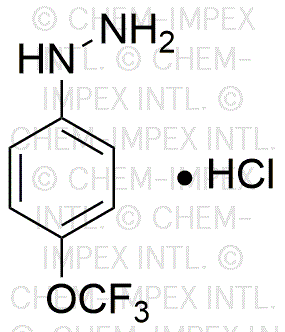4-(Trifluoromethoxy)phenylhydrazine hydrochloride is widely utilized in research focused on:
- Pharmaceutical Development: This compound serves as an intermediate in the synthesis of various pharmaceuticals, particularly in developing anti-cancer agents. Its unique trifluoromethoxy group enhances biological activity.
- Agricultural Chemicals: It is used in formulating agrochemicals, especially herbicides and fungicides, due to its ability to disrupt specific biochemical pathways in pests while being less toxic to non-target organisms.
- Material Science: The compound finds applications in creating advanced materials, including polymers and coatings, where its chemical properties contribute to improved durability and resistance to environmental factors.
- Analytical Chemistry: It is employed as a reagent in various analytical techniques, helping researchers detect and quantify specific compounds in complex mixtures, thus enhancing the accuracy of their analyses.
- Research on Fluorinated Compounds: As a fluorinated compound, it plays a crucial role in studies exploring the effects of fluorine substitution in organic molecules, aiding in the development of new materials with tailored properties.
General Information
Properties
Safety and Regulations
Applications
4-(Trifluoromethoxy)phenylhydrazine hydrochloride is widely utilized in research focused on:
- Pharmaceutical Development: This compound serves as an intermediate in the synthesis of various pharmaceuticals, particularly in developing anti-cancer agents. Its unique trifluoromethoxy group enhances biological activity.
- Agricultural Chemicals: It is used in formulating agrochemicals, especially herbicides and fungicides, due to its ability to disrupt specific biochemical pathways in pests while being less toxic to non-target organisms.
- Material Science: The compound finds applications in creating advanced materials, including polymers and coatings, where its chemical properties contribute to improved durability and resistance to environmental factors.
- Analytical Chemistry: It is employed as a reagent in various analytical techniques, helping researchers detect and quantify specific compounds in complex mixtures, thus enhancing the accuracy of their analyses.
- Research on Fluorinated Compounds: As a fluorinated compound, it plays a crucial role in studies exploring the effects of fluorine substitution in organic molecules, aiding in the development of new materials with tailored properties.
Documents
Safety Data Sheets (SDS)
The SDS provides comprehensive safety information on handling, storage, and disposal of the product.
Product Specification (PS)
The PS provides a comprehensive breakdown of the product’s properties, including chemical composition, physical state, purity, and storage requirements. It also details acceptable quality ranges and the product's intended applications.
Certificates of Analysis (COA)
Search for Certificates of Analysis (COA) by entering the products Lot Number. Lot and Batch Numbers can be found on a product’s label following the words ‘Lot’ or ‘Batch’.
*Catalog Number
*Lot Number
Certificates Of Origin (COO)
This COO confirms the country where the product was manufactured, and also details the materials and components used in it and whether it is derived from natural, synthetic, or other specific sources. This certificate may be required for customs, trade, and regulatory compliance.
*Catalog Number
*Lot Number
Safety Data Sheets (SDS)
The SDS provides comprehensive safety information on handling, storage, and disposal of the product.
DownloadProduct Specification (PS)
The PS provides a comprehensive breakdown of the product’s properties, including chemical composition, physical state, purity, and storage requirements. It also details acceptable quality ranges and the product's intended applications.
DownloadCertificates of Analysis (COA)
Search for Certificates of Analysis (COA) by entering the products Lot Number. Lot and Batch Numbers can be found on a product’s label following the words ‘Lot’ or ‘Batch’.
*Catalog Number
*Lot Number
Certificates Of Origin (COO)
This COO confirms the country where the product was manufactured, and also details the materials and components used in it and whether it is derived from natural, synthetic, or other specific sources. This certificate may be required for customs, trade, and regulatory compliance.


